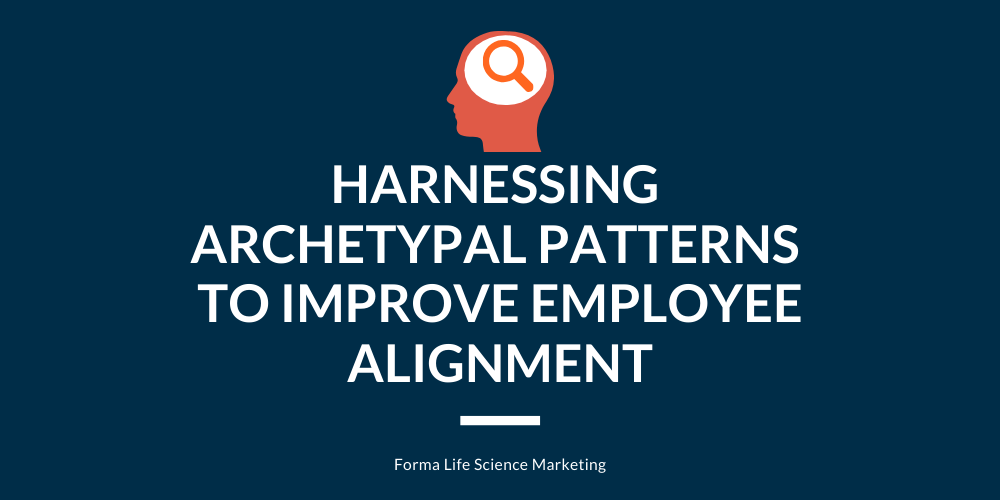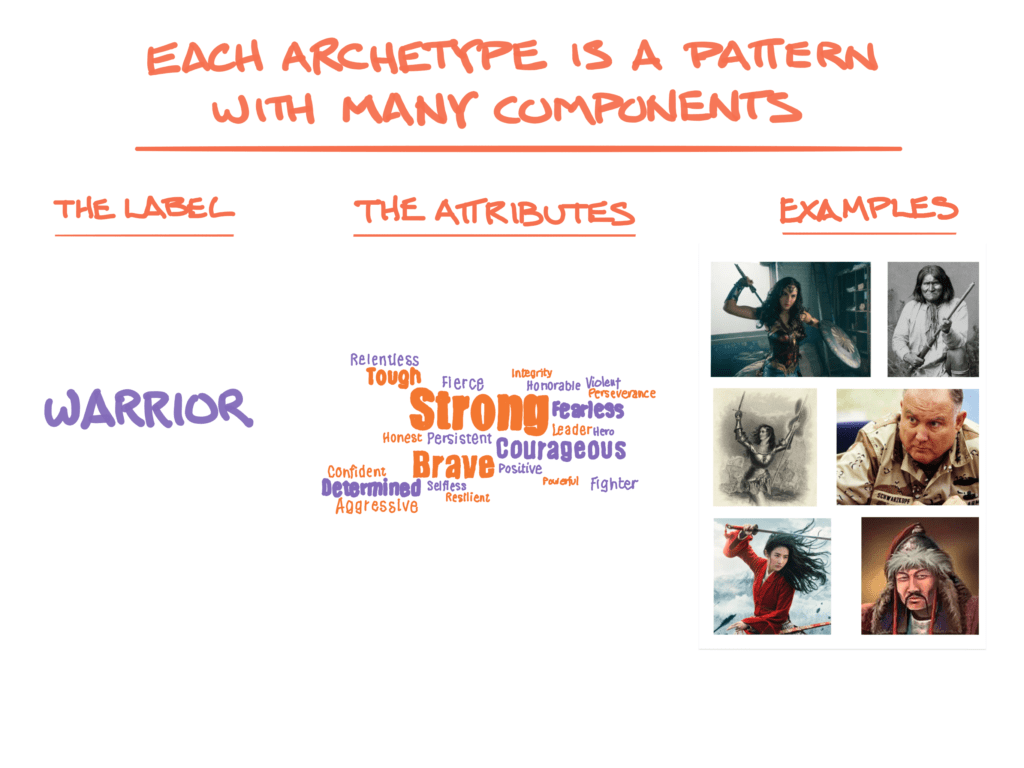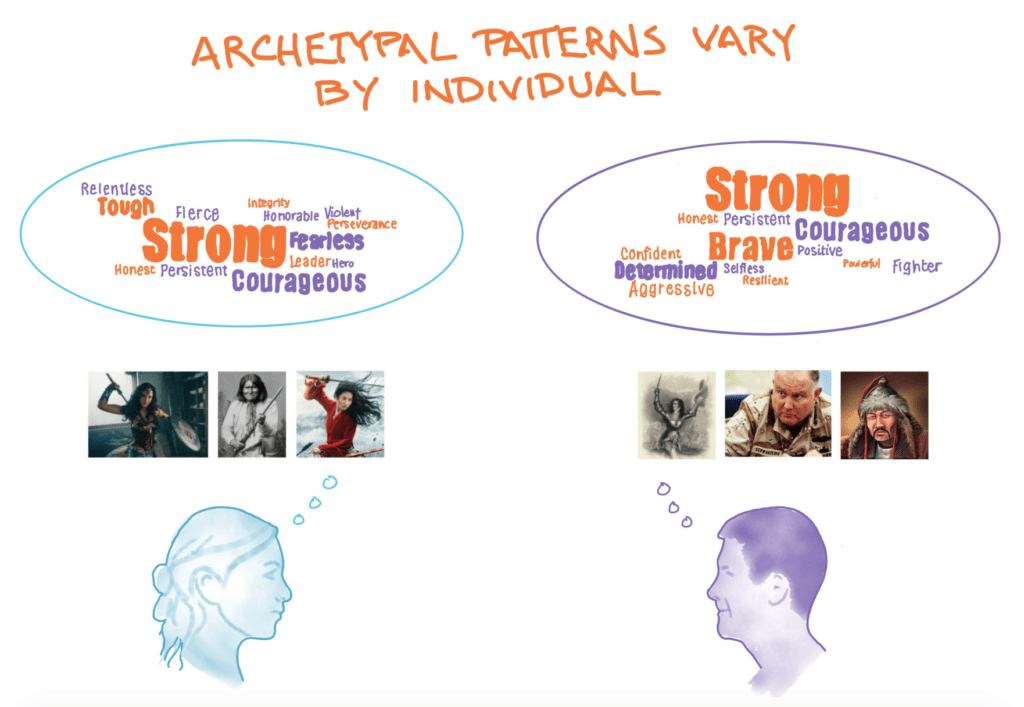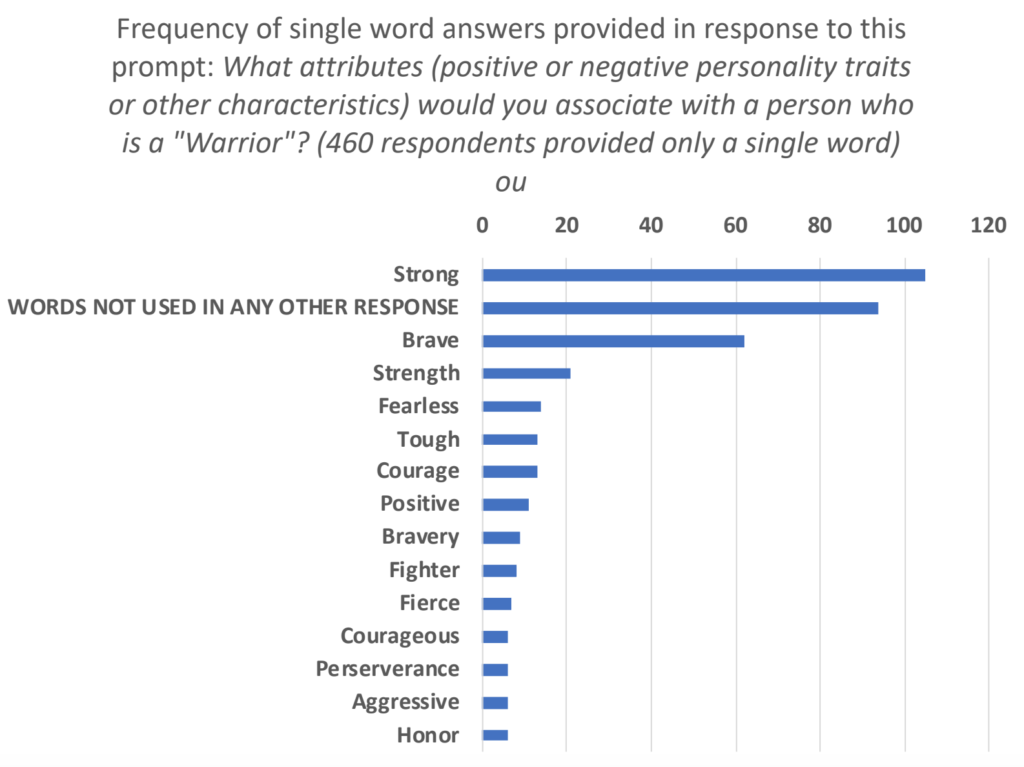Harnessing Archetypal Patterns to Improve Employee Alignment
By David Chapin

SUMMARY
VOLUME 12
, NUMER 2
One of the surprising benefits of using archetypes is that when properly applied, they can dramatically improve employee alignment and team performance. How? In this issue, I unpack the specific nature of archetypal patterns and dig into research which reveals that these patterns are not identical from one person to the next.
Archetypal patterns were originally used in marketing to differentiate
The use of archetypal patterns in marketing is relatively new; they were first employed about twenty years ago, primarily to differentiate consumer products and services that were otherwise quite similar—think packaged food, athletic shoes, laundry detergent, and the ultimate commodity, bottled water.
For more on using archetypes to differentiate, see our whitepaper on gaining differentiation through pricing power and the seminal book The Hero and the Outlaw by Mark and Pearson.
The ability to further differentiate products and services was one of the reasons Forma’s team was originally attracted to archetypes, as most of our clients work in sectors where regulatory pressures force homogenization of both work product and work process. While the technical aspect of these life science goods and services is quite a bit more complex than diet soda, cat food, or chicken sandwiches, they do share a similarity: all are difficult to differentiate. This makes them ideal candidates for the application of archetypes.
Forma’s team has been optimizing the use of archetypes with our clients for over 20 years. If you aren’t caught up, archetypes are patterns that we all carry in our heads; examples include the Protester, the Hero, the Sovereign, the Lover. There are thousands of these patterns—and you can learn more about this topic on Forma’s Archetype page.
There are additional benefits to using archetypal patterns correctly
Differentiation is certainly important. But as we’ve become more sophisticated in our use of archetypal patterns here at Forma, many benefits beyond differentiation (and the pricing power that comes with it) have come to light. When applied expertly, they also enable:
- Improved clarity of messages
- Increased consistency in messages and tone of voice
- The ability to harness and guide an organization’s articulation (the second dimension of differentiation)
- Close coordination of internal and external narratives (“a single narrative”)
- And the benefit mentioned above: increased differentiation (resulting in better pricing power).
Archetypal patterns can drive employee alignment and improved team performance
Since we’ve started including archetypal patterns in our marketing toolbox, we’ve learned quite a bit about how to sharpen this tool and apply it more effectively. One of the most surprising things we’ve learned is how powerful archetypal patterns can be in creating a whole other set of benefits, specifically increases in employee engagement and team performance. Additional reading on maximizing employee alignment can be found here.
How do archetypal patterns drive employee alignment?
The data are very clear: when properly applied, archetypal patterns help align and engage employees. I originally thought that this alignment was due to the nature of the pattern that each employee carries in their heads. If everyone carries the same pattern for “Sage,” then getting employees to act as a Sage would yield alignment.
To uncover the mechanism by which archetypes drive alignment, I needed to know: How similar are those archetypal patterns we carry in our heads—are they actually identical, only vaguely similar, or somewhere in the middle?
The three components of archetypes
To answer this question, we have to look closely at these archetypal patterns. Each contains a label (e.g., Warrior), attributes (e.g., Strong, Fierce, Goal-oriented, Skilled, etc.) and examples (Alexander the Great, General George Patton, Wonder Woman, etc.).

Archetypes are patterns that we carry in our heads. Each archetype’s pattern consists of at least three main components: the label, some examples, and a set of attributes.
All of these components are packaged together as a pattern in our heads. That’s a lot of patterns (12 main archetypes in our wheel times 4 or 5 key subgroups each plus 1000s of other variants…). Most of the time, we don’t need to think about the vast majority of these packages. When we’re watching a rom-com, for instance, we don’t have to unpack—or activate—the Warrior pattern; similarly, we typically won’t mentally reference the Lover archetypal pattern when reading a news report on soybean production.
Unpacking archetypal patterns
I’ve written about how research we’ve conducted shows there are (at least) three types of mechanisms that can unpack or activate an archetype’s pattern:
- Exposure to the label of the archetype causes the viewer to unpack the archetype’s pattern. If you hear the word Warrior, you’ll unpack the pattern in your head, and then you’ll be predisposed to expect specific types of behaviors which align with the attributes that make up the pattern in your head (team-oriented, highly-trained, etc.).
- Exposure to the pattern of the behavioral attributes causes you to unpack even more of the archetype’s pattern of attributes. If you see behaviors that match part of the Warrior pattern you have in your brain, you’re predisposed to expect additional behaviors described by the other aspects of this pattern. In essence, you expect any organization exhibiting part of the pattern to exhibit the entire pattern—you expect the pattern to be completed.
- Exposure to the pattern causes you to be more likely to associate the (correct) label with this pattern. If you see behaviors that match part of the Warrior pattern you have in your brain, you’re likely to attach a label to this pattern.
In all of these cases something small (the label, or a small part of the pattern) unlocks or activates a larger pattern, including the label if it hasn’t been provided. This is analogous to the so-called Central Dogma in biology, the name for the gene expression process by which DNA gets “expanded” by the action of RNA polymerases into RNA and thence to protein. In the Central Dogma, something smaller instigates the activation of something larger. This is similar to what happens with archetypes. Something smaller, either the label of the archetype or a part of the pattern, instigates the activation of a something larger, such as a more complete pattern of archetype behaviors and the label of the pattern.
How unique are archetypal patterns?
If everyone carries the exact same pattern for any given archetype, then this could explain why the use of archetypes drives increased employee alignment. Once the label of the archetype (and some examples) are provided, then every employee would unpack the same, identical pattern. If we give them the right incentives to use this archetype as a guide to their behavior, each employee will know exactly how they should behave. Voila: increased alignment.
The question I asked above (how similar are the archetypal patterns we carry?), can actually be broken down into two related questions: for any one archetype, how similar are the attributes individuals associate with that archetype, and how similar are the examples? I conducted some research to find out.
Your Warrior is similar, but not identical, to my Warrior!
Spoiler alert: My research has revealed that the pattern one individual carries for any one particular archetype is similar but not identical to the pattern that most other people carry. While the label may be the same, the examples, the attributes and the definitions of these attributes will be distinct to any one individual. See Figure 2.

The pattern that you carry in your head associated with any specific archetypal label—such as the “Warrior”—will likely be different from the pattern someone else carries in theirs. Each of these patterns is unique to you; the pattern for Warrior in your brain will only rarely match the pattern of someone else.
The research did show that some archetypal patterns seem to be more similar from person to person (e.g., Detective), while some have much less similarity (e.g., Hero). The differences in these patterns may be large or small, but there will be differences. How do we know this? I’ll give you a description of two research studies I’ve conducted into archetypal patterns. If you want to skip the details of the research and fast-forward to the implications, please go ahead—head to the section below entitled What does this mean for employee alignment?
Are an archetype’s attributes the same from individual to individual?
In one research project, I used Google Surveys to ask a single question: What attributes (positive or negative personality traits or other characteristics) would you associate with a person who is a warrior? Please enter up to 3 answers.
I received 1000 responses from people aged 18 and up, distributed fairly evenly across the US, and divided almost equally between men and women. To analyze these data, I first removed all the useless responses, which included a mix of scatological, political or nonsense answers. I then divided the remaining responses (n=860) into those with one word (n=460), and two or more words (n=400).
The amount of similarity among the answers gives us a clue about the similarity of the respondents’ patterns. If the archetypal patterns were identical, we’d expect all the one-word responses to be the same; all the two-word responses to be the same identical pair of words, and the three-word responses to all be the same word triplet.
One-word descriptions vary widely
For the Warrior research described above, the one-word responses vary widely, but follow a general theme. For those 460 single-word responses, the frequency of the most popular words is shown in the following figure. Even the most frequent word (Strong) was used by only 23% of the respondents. The second most common response was the collection of unique words used by only a single respondent. In other words, very few of the responses were identical. The pattern of attributes unlocked by the label Warrior was not identical among the respondents.

This chart plots the frequency of single word responses. Two things are worth noting. First: there is similarity among the general meaning of the words selected. To see this, note that Brave, Bravery, Fearless and Courage are all used, as are Strong and Strength, and Fierce and Tough. Second, while the overall pattern shares some commonalities, there is great variation within this overall pattern. Unique words (that is, words used only by one single respondent) constitute at least 23% of the entire sample.
Multi-word descriptions also vary widely
Three-word responses also vary. Among the 327 three-word (triplet) responses, identical responses (the exact same words used by different respondents) were quite rare. The most any triplet appeared was three times—that’s less than 1%. Only 11 triplets showed up twice. The number of completely unique triplets (distinct words used in any order) was staggeringly high: a total of 92.3% of responses. Again, the pattern of attributes unlocked by the label Warrior was not identical among the respondents.
Isn’t this interesting? The pattern of attributes from all the respondents have some similarity and overlap, but are a long way from being completely identical. This overlap but non-identicality is a feature of every archetypal pattern I’ve examined. Similar results have been found in research I’ve conducted on other archetypes such as Detective, Jester, and Clown.
How identical is another part of the pattern: the examples?
If I asked you to name some examples of a Warrior, who would you choose? Wonder Woman, Alexander the Great, Conan the Barbarian, Hercules, General George Patton, Attila the Hun, Hannibal, Leonidas? How similar would your answer be to others?
I conducted an online survey with 50 people aged 18 and up, distributed fairly evenly across the US, and divided almost equally between men and women. I asked respondents to name (up to) three examples of real or imaginary Warriors. If the patterns we all carried in our heads were identical, the same examples would always be mentioned. As you can see in Figure 4, this was not the case. The number of unique answers (number of answers given only once) is quite high.
For Warrior, the most any individual warrior was mentioned was three times, out of the 50 meaningful answers received. Only 13 warriors were mentioned more than once; 38 were mentioned only once.

Mention of unique examples of Warriors was far more common than mention of similar examples.
Interestingly, in this case the results were different when the stimulus was Detective. As you can see from figure 5, one example stood deer-stalker hat and shoulders above the rest: Sherlock Holmes.

One specific Detective example dominated the responses: Sherlock Holmes, who received 22 mentions out of 35 total Detectives mentioned. I believe, but have not confirmed through research, that this “popularity” of a single example is rare.
One person’s Sovereign is another person’s Dictator
Even with this single dominant response, the Detective pattern was not even close to identical among all respondents.
Which is a clear demonstration of the fact that the archetypal patterns we carry in our heads are similar, but are not identical. Your Warrior is different from my Warrior, in attributes and examples. Your Warrior, in fact, may match one of the patterns in my head that’s close to the Warrior, such as the Hero. Your Sovereign may match my Dictator.
I believe that many things account for these differences, including the culture in which you are raised, the stories you heard when you were young, and the specific movies and books you’ve recently read, just to mention a few possible factors. If this is true, it raises another interesting point: each individual’s archetypal pattern for any given archetype is not fixed throughout their life, but changes over time. For example, your conception of a Hero may have been different before the start of the Covid19 pandemic than after, with all the media discussion of “health care heroes.”
What does this mean for employee alignment?
Archetypal patterns are similar, but not identical, from individual to individual. If every employee knew they should behave like a Warrior, then some behavioral alignment would automatically follow. But there wouldn’t be complete consistency in behavior, because there isn’t complete consistency in the patterns. In fact, as the research mentioned above reveals, the odds of any two people sharing the exact same pattern is quite low, and the odds drop even further when you either add more people (which we want to do, so we can include all our employees) or increase the number of attributes in the pattern (which we want to do—within reason—so we can clearly specify the types of behaviors we expect from these employees).
What does this mean? It means that there are two possible levels of employee alignment available from the use of archetypes. We can get the first level of employee alignment just by using an archetype. The resulting (smaller) amount of alignment will come from the similarity between patterns. If we want greater employee alignment, we have to do more than just use an archetype as a touchstone. We need to carefully define the archetype and get everyone to use the archetype as a behavioral guide.
In other words, to get the maximum possible employee alignment, we have to accomplish three things. First, we have to clearly define what the archetype means (what attributes we want to embody), second, we have to align every employee’s understanding of our clearly defined attributes, and third, we have to help them use this pattern to guide their behavior. These are not simple to accomplish, but can be done—as our work with clients can demonstrate.
Making the archetypal pattern more specific
To harness the power of archetypes and get to the second level of employee alignment, we have to start with the first accomplishment listed above: clearly define what our archetype stands for and what behavioral attributes constitute the pattern. As we do this, we have an opportunity to harness what science has revealed about maximizing three aspects of our employees’ experience. These aspects are, in essence, viewpoints that give us leverage to achieve the greatest employee alignment.
In the next issue, I’ll introduce these three viewpoints:
- The secrets of motivating individual employees,
- The secrets of creating high performance teams, and
- The secrets to creating a highly effective organizational culture.
Each viewpoint has unique characteristics that enable us to use archetypes effectively. I’ll reveal how we can harness what science knows about these three viewpoints to maximize the effectiveness of archetypes in driving employee alignment.
As always, if you’d like to have a short conversation about how Forma can help your life science company become more aligned, don’t hesitate to reach out on our contact form!
The Marketing of Science is published by Forma Life Science Marketing approximately ten times per year. To subscribe to this free publication, email us at info@formalifesciencemarketing.com.
David Chapin is author of the book “The Marketing of Science: Making the Complex Compelling,” available now from Rockbench Press and on Amazon. He was named Best Consultant in the inaugural 2013 BDO Triangle Life Science Awards. David serves on the board of NCBio.
David has a Bachelor’s degree in Physics from Swarthmore College and a Master’s degree in Design from NC State University. He is the named inventor on more than forty patents in the US and abroad. His work has been recognized by AIGA, and featured in publications such as the Harvard Business Review, ID magazine, Print magazine, Design News magazine and Medical Marketing and Media. David has authored articles published by Life Science Leader, Impact, and PharmaExec magazines and MedAd News. He has taught at the Kenan-Flagler Business School at UNC-Chapel Hill and at the College of Design at NC State University. He has lectured and presented to numerous groups about various topics in marketing.
Forma Life Science Marketing is a leading marketing firm for life science, companies. Forma works with life science organizations to increase marketing effectiveness and drive revenue, differentiate organizations, focus their messages and align their employee teams. Forma distills and communicates complex messages into compelling communications; we make the complex compelling.
© 2024 Forma Life Science Marketing, Inc. All rights reserved. No part of this document may be reproduced or transmitted without obtaining written permission from Forma Life Science Marketing.
